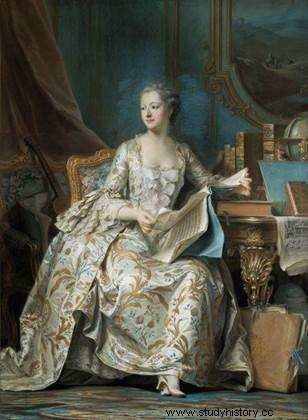 Before the portrait of the Marquise de Pompadour, Quentin de La Tour , portrait painter and pastel painter born in 1704, first produced the portrait of Voltaire in 1735. Following with those of Rousseau, Louis XV, his wife and the Dauphin, he was received at the Royal Academy of Painting and Sculpture, in as a "painter of pastel portraits" in 1746 and became an adviser in 1750. Specializing in portraits, he made them so alive, so smiling, so sensitive that you imagine having the characters in front of you. In his hometown, he founded a drawing school in 1782 and still today, the Antoine Lécuyer museum in Saint Quentin retains most of his work.
Before the portrait of the Marquise de Pompadour, Quentin de La Tour , portrait painter and pastel painter born in 1704, first produced the portrait of Voltaire in 1735. Following with those of Rousseau, Louis XV, his wife and the Dauphin, he was received at the Royal Academy of Painting and Sculpture, in as a "painter of pastel portraits" in 1746 and became an adviser in 1750. Specializing in portraits, he made them so alive, so smiling, so sensitive that you imagine having the characters in front of you. In his hometown, he founded a drawing school in 1782 and still today, the Antoine Lécuyer museum in Saint Quentin retains most of his work.
The Pompadour, by Delatour
One fine day in 1749, the former royal mistress of Louis XV, Madame de Pompadour asked Quentin de La Tour to paint her portrait. The artist will use pastel pencils supplemented with a few touches of gouache, but five years are necessary until its completion, because it is regularly "tricked by the ear":he refuses to go to paint in Versailles and pronounces these words "I'm not going to paint in town" or even he claims urgent repairs to be made on other canvases… Finally the face is prepared in Versailles and the portrait is painted in the Paris workshops. Once completed, it was exhibited at the Salon in 1755 and then acquired by the Louvre in 1803.

The marquise is thirty four years old. Having reached the stage of friend and adviser to the king, who has become grace itself, she sits like a queen in her cabinet decorated with blue-green woodwork, underlined in gold, wearing a sumptuous satin "à la française" dress. , as we admire on the magnificent portrait in a room of the Louvre…
The fashion for the French dress with separate baskets only appeared in 1750 and these volumes gave more comfort and ease of movement. Do you know ladies that baskets are the origin of our handbags? Indeed, there is another advantage to these baskets:the ladies, under their lace petticoats of which we discover a small piece, could place all their feminine necessities there.
The cuffs with removable lace and nicknamed "les engagingantes" make the marquise even more feminine and refined. The knots of the plastron as well as the little mules at the foot are in the new soft pink tone:the "pink Pompadour" and unlike this sumptuous dress, her hairstyle is simple, devoid of her hats of all sizes which are fashion…because she is in her private.
Surrounded by all the elements of her intellectual life including a sphere, books, music scores, the Spirit of the Laws, the Encyclopedia, a viola, cardboard boxes drawings, Madame de Pompadour is the Protector of All the Arts. Let's not forget that it was thanks to her that the Sèvres factory had its new boom around 1765 and that it thus inaugurated the "Pompadour style" in the decorative arts.
A woman of taste, cultured and artistic, feminine, elegant and graceful who opened up to the philosophical, political and moral evolution of Paris… “La Femme” of the 18th century century!
With this portrait of one meter seventy long by one meter thirty wide, Quentin de La Tour had just inaugurated a new technique and was able to prove that pastel can equal oil painting. But with this work, it is also the end of the fashion for official portraits...
The Marquise de Pompadour , By delatour. Louvre Museum.
